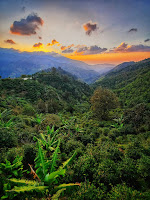Coffee Explorer
Join Jen Stone, Licensed Coffee Quality Grader, as she sources and tastes the world's most spectacular coffees. Peek behind the curtain, meet amazing people and learn about the extraordinary world of coffee. Visit www.Ciel.World to taste her favorite coffees.
Wednesday, January 20, 2021
Friday, December 25, 2020
Wednesday, December 9, 2020
Saturday, December 5, 2020
Friday, October 23, 2020
Tuesday, October 20, 2020
Tuesday, September 29, 2020
Saturday, August 29, 2020
Geisha? SL28? Variety in Coffee
Just like wine, coffee has different varieties. A specific subspecies or genetic makeup that plays a role in how it grows and tastes. In wine, there is Pinot Noir, Merlot, Malbec, Chardonnay. In coffee, you have Bourbon, Caturra, Geisha and SL28. In wine, considering the variety is an excellent place to start in beginning to determine what glass you might want with dinner.
In coffee, the variety has capriciously become the topic of conversation due to the high auction prices (and quality) of the Geisha variety. Yet, otherwise, variety is not at forefront of the coffee selection process by consumers. As so much happens to the coffee cherry after being picked, relying on the variety to dictate, or take the lead the flavor is not in the highest contributing factors.
*By the way, the words “variety”, “varietal” and “cultivar” are used interchangeably in coffee parlance.*
There are thousands of coffee varieties with new hybrids being created each year. That said, there are about 20 – 30 that are most common in specialty coffee today. We can explore a few and learn about their general taste characteristics and how they are utilized by producers.
Bourbon – from the island of Bourbon (now Reunion Island); smaller cherries, and different varieties are red, orange or yellow when ripe. Has a light body; sweet taste
Caturra – named after a town in Brazil; mature shrub is small; works well for espresso A truly wild Caturra
Geisha – originated near Gesha, Ethiopia; grows better at higher altitudes over 5000 ft; distinct floral characteristics, tea-like. The Rockstar - Panama Geisha
Pacamara – created in El Salvador from Pacas and Maragogype cultivars; large beans; bright acidity
SL28 – created by Scott Laboratories; disease resistant; pronounced acidity and red fruit flavors SL28 from Costa Rica - SL28 from Kenya
Some varieties were created for resilience, some for flavor. Challenges arise in discovering these distinct tastes, as roast styles and brewing methods combine to alter the final cup.
As you explore the world of coffee, understanding varieties can help you discover preferences. For example, I don’t care for the taste that the Castillo variety has – it has a harsh, hard, cinnamon spice aspect. However, in 2008 – 2009, Colombia had a perfect storm of pests (broca), leaf rust (la roya) and weather issues (el Nino and la Nina). Castillo trees were planted across Colombia, which were hardy and resilient, and they saved the country from a devastation and about one-third of the country in questionable employment. I have had it washed, natural processed and blended with other varieties, like catuai, and it dominates the process. On the other hand, I do like savory Pacamaras, which have a hint of alliaceous flavors.
So, when you see a coffee brand include the variety on the already crowded coffee information panel, it isn’t showy or vanity, but rather an effort to assist and educate. More on that in future posts.
As you explore the world of coffee, understanding varieties can help you discover new preferences.
Monday, August 3, 2020
Friday, July 3, 2020
Quality Criteria
Ciel is an independent, small batch coffee roaster with a passion for selecting and roasting only the world’s finest coffees.
Our commitment to excellence is evident in every aspect of our process, from the way in which we procure our coffees to our precision roasting protocols and finally, in the attention to detail we attribute to each coffee at every step along the way.
From the world’s elite growers to your cup, you can be assured that each and every coffee within our portfolio is the world’s most exceptional.










